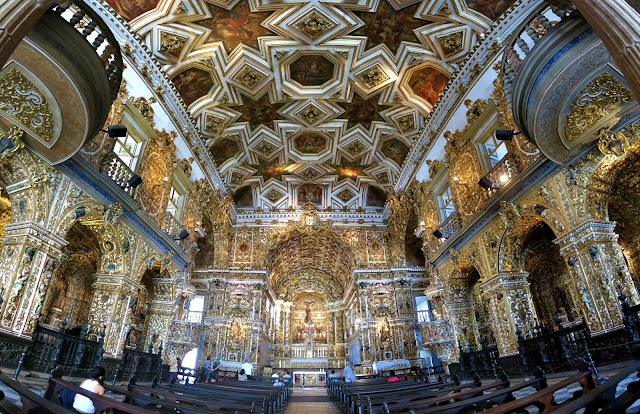 |
| Von BrunoEspindola84 - Eigenes Werk, CC BY-SA 4.0, https://commons.wikimedia.org/w/index.php?curid=43881597 |
Brazil has become a new interest for me. Host to the Olympics and the Football World Cup it reached the headlines. Since then politics have taken a sharp turn to the right. As I write the Pandemic is hitting really hard and many mistakes have been made. Despite the need for social distancing reports come in of crowds on Copacabana Beach in Rio and stalls to serve them.
Salvador, now capital of Bahia province was the first capital of the Portuguese colony of Brazil. It remained capital until 1763. Unlike Mexican cities it was not built on a checkerboard plan. Rather it developed according to economic needs and administration. Therefore we have the port in the lower city and the former colonial churches, monasteries, and government buildings in the upper city. By 1800 there were over 70,000 in total with 6 monasteries and 6 nunneries.
Perhaps the most famous of these was the Franciscan foundation which began when they arrived in 1587.The first church was destroyed in the Dutch invasion during the 17th century. The rebuild of the convent began in 1686 and the church was built 1708-1723. It has been called one of the Seven Wonders of Portuguese origin in the world. The whole Franciscan convent is one of the biggest structures of colonial Brazil. A Baroque skeleton infused with Rococo sinuosity. It has a dramatic site off a public square with the nearby Jesuit church. As the headquarters of the Franciscans in Brazil it contained college and an important library.
It was achieved by Franciscan architects and craftsmen and the professional architect Manoel Quaresma 1686-1737. The facade is quite plain with no pillars, no curving entablatures, and two flanking towers topped with short spires. By contrast the interior is a rich frenzy of Baroque wood carving, stucco ornamentation all polychromed and gilded. A superb example of the igreja dourada (golden church) Brazilian church style. The interior decoration took until 1755. I find this very hard to describe in words. There are no straight lines in the decor , restless, fantastic- it is overwhelming. The stuccoed angels, the floral motifs, golden, dazzling. The ceiling is painted with star shaped images of angels reminding us of Italian illusionist ceilings. Then we have the blue and white tiles (azulejos) on remaining wall surfaces. These are a big feature of Portuguese churches and secular buildings in the Baroque. The ones here were painted by the great tile artist Bartolomeu Antunes de Jesus in Lisbon. There are said to be 55,000 azulejos in San Francisco - the most in any South American church. The chancel is narrower and the most "over the top" section of the church - quite shocking to some British eyes I expect! Golden nesting arches above set off this monumental theatrum sacrum.
Now you must experience this amazing 3 dimensional film of the interior. Do use this link!
The cloister in two storeys has 35,000 azulejos featuring 37 panels of the works of Horace - a surprising subject I would have thought. They also came from Portugal and were installed in 1748.
The sacristy has a coffered ceiling, inevitably more azulejos, Baroque altar and surviving Baroque furniture.
 |
| By Lazaroagmenezes - Own work, CC BY-SA 4.0, https://commons.wikimedia.org/w/index.php?curid=82373773 |
 |
| By Biblioteca de Arte / Art Library Fundação Calouste Gulbenkian - Convento de São Francisco, Salvador, BrasilUploaded by tm, No restrictions, https://commons.wikimedia.org/w/index.php?curid=24835663 |
 |
| By Leon petrosyan - Own work, CC BY-SA 4.0, https://commons.wikimedia.org/w/index.php?curid=38841915 |
 |
| By fernando_dallacqua [2] - Flickr [1], CC BY 2.0, https://commons.wikimedia.org/w/index.php?curid=2581788 |

No comments:
Post a Comment